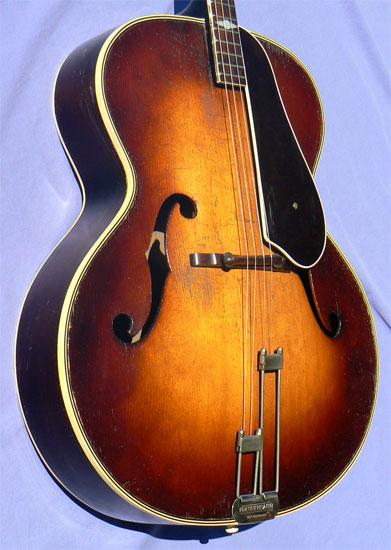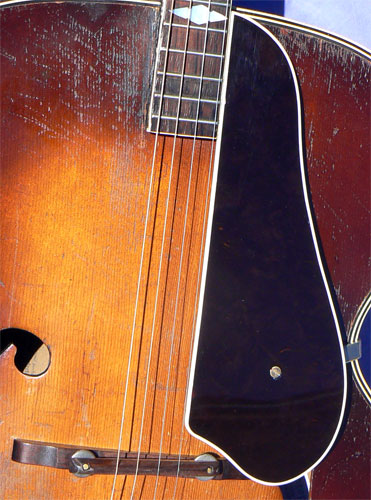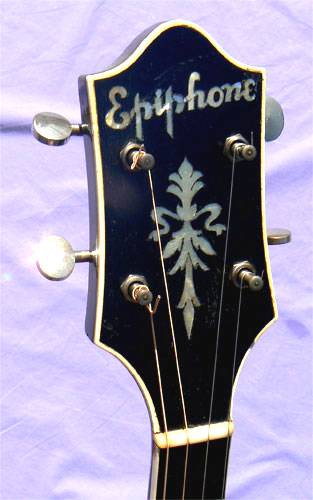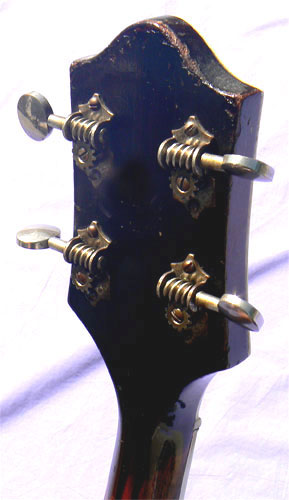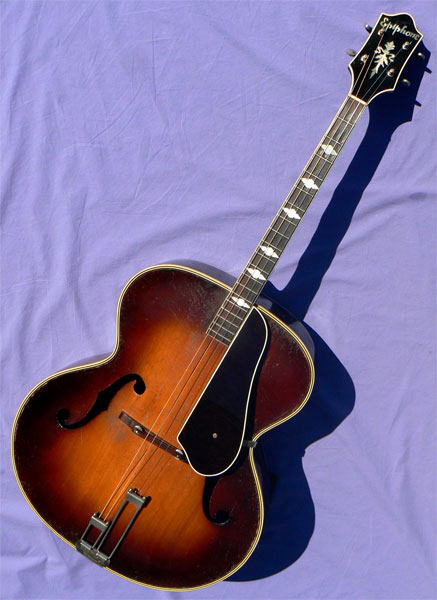
Home / Instruments /Accessories / Ordering / Tips / Friends
archtop.com
1938 Epiphone Masterbilt Triumph Tenor
Status: Pricing and hold status for all instruments currently available is shown on our Instruments page here. If this instrument does not appear on the Instruments page it has been sold, and is no longer available. Photos and descriptions of Previously Sold instruments may by found here. To be notified of examples of this model or similar instruments in the future, please contact [email protected],. Please be specific on which instrument(s) you're looking for, and we'll be happy to contact you as soon as they become available.
Serial #: 13271, NY Masterbilt label
Body size at lower bout: 17 3/8" Scale length: 23". Nut width: 1 3/16" Neck depth, 1st/10th frets: .90/1.05
Materials: Solid bookmatched Adirondack spruce top; solid hand carved curly maple back; solid cherry neck with 3-ply walnut/maple centerstripe; rosewood fingerboard with mother of pearl diamond inlays; "snowflake" mother-of-pearl peghead inlay, 5-ply top binding, bound fingerboard and headstock.
Hardware: Original nickel hardware includes Pat. Pend. Frequensator tailpiece, Grover Sta-Tite tuners, compensated adjustable rosewood bridge. Vintage correct bound tortoise pickguard.
Notes: As the banjo began to fall from favor in the late 20's, Epiphone began making tenor guitars initially under its ornate Recording series. With their introduction of archtop guitars in 1931, the firm debuted a new line of tenors, named in parallel to their six string counterparts. The tenor version of the Triumph was dubbed the Hollywood, with a 13" body, quickly upsized to 15" the following year. By 1935 the model had been renamed the Triumph Tenor, and enlarged to its final 17 3/8" size, remaining available on special order until the firm's closing in 1956.
Like its Gibson counterpart, the L-7 tenor, 17" body tenor guitars were both rare and costly, which accounts for the notable scarcity of the Triumph Tenor as well. (In over three decades, this is the first one of these big beauties we've ever had the pleasure to present.) This rare example from 1938 is a one-owner guitar, and kept in the family since its purchase brand new in the Great Depression.
One of the first to be fitted with Epiphone's new Frequensator tailpiece, the guitar is also equipped with its original Grover Sta-Tite tuners and compensated adjustable rosewood bridge. The arched peghead design is one of Epi's rarest as well, seen only between 1936 and 1938, as well as the curvilinear body, enlarged f-holes, and large 5 ply binding. The pearl work includes the graceful prewar snowflake peghead inlay, and the traditional Triumph diamond fret markers.
A true bandstand veteran, the guitar has been maintained in solid playing condition, with all original sunburst finish, showing moderate pick and finish wear for an instrument of its considerable vintage. Some flame figure is visible in the solid maple back, and the top is carved from solid Adirondack spruce. The 'banjo wire' fretwork appears original and in good condition, with a fresh high precision setup over a finely figured rosewood fingerboard, still admirably straight. The original binding remains tight to the body and the Frequensator tailpiece remains solid at the bend.
Decades of vigorous play have lent the instrument a distinctly clear, open voice, with warm resonance and exceptional projection. The neck is easy and fast for a prewar guitar, with a slightly veed profile that sits nimbly in the hand. Apart from a short hairline crack of about an inch at the treble soundhole, and a small crack at the back waist, both soundly resealed, the instrument shows no other apparent repairs.
A fine example of one of the rarest of all Epiphone models, ready for its next turn at the jam session, and complete with its original Epiphone hardshell case. One only: call now.
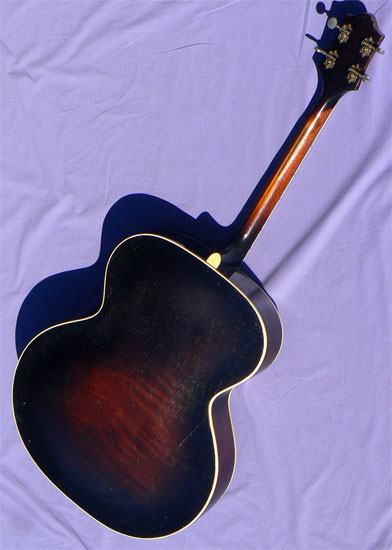 Setup: The frets have been
Setup: The frets have been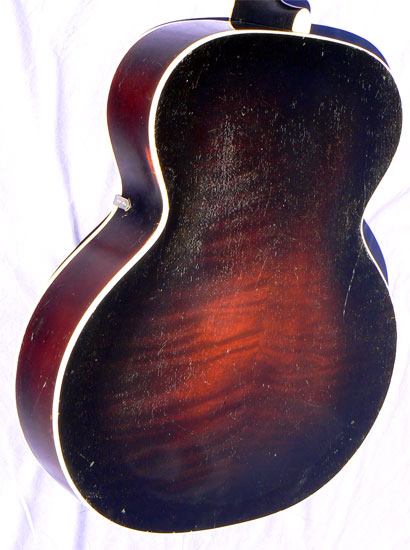 precision leveled, recrowned and polished; trussrod tension and neck relief adjusted; bridge height adjusted; bridge compensation set; string slots at nut and bridge inspected and recut as necessary; bridge foot contour inspected and fit to top as necessary; bridge radius inspected and recurved as necessary; bridgewheels and tuners lubricated; fingerboard and bridge oiled; body and neck cleaned and hand polished.
precision leveled, recrowned and polished; trussrod tension and neck relief adjusted; bridge height adjusted; bridge compensation set; string slots at nut and bridge inspected and recut as necessary; bridge foot contour inspected and fit to top as necessary; bridge radius inspected and recurved as necessary; bridgewheels and tuners lubricated; fingerboard and bridge oiled; body and neck cleaned and hand polished.
This instrument is strung with medium gauge bronze strings. The guitar will accommodate lighter or heavier gauge strings, according to preference. String action is set at 4/64" to /64" at the 12th fret, with moderate relief for acoustic playing with medium strings. The action may be lowered or raised to your requirements with the adjustable bridge.
